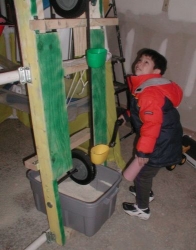Designers: Martin Elisco
Client Coordinators: Jodi Petri, OT, Lenox Baker Children’s Hospital
Supervising Professor: Dr. Larry N. Bohs
 The client is a six-year-old boy exhibiting symptoms of autism and manic depression. These symptoms manifest in his desire to constantly pour liquids and granular objects. He will pour for as many hours as allowed, but the mess produced, lack of supervision, and inclement weather when he pours outdoors, among other restrictions, prevent him from always engaging in this important activity. The Pouring Palace is a large structure that incorporates different activities that involve pouring granular objects such as rice or beans. These activities include a cranking and lifting mechanism that hoists the material above the structure and pours it over objects that the client can configure on a pegboard, a magnetic board for him to affix objects over which he can pour manually, and various bins to hold the material for him to create pouring activities with his own imagination.
The client is a six-year-old boy exhibiting symptoms of autism and manic depression. These symptoms manifest in his desire to constantly pour liquids and granular objects. He will pour for as many hours as allowed, but the mess produced, lack of supervision, and inclement weather when he pours outdoors, among other restrictions, prevent him from always engaging in this important activity. The Pouring Palace is a large structure that incorporates different activities that involve pouring granular objects such as rice or beans. These activities include a cranking and lifting mechanism that hoists the material above the structure and pours it over objects that the client can configure on a pegboard, a magnetic board for him to affix objects over which he can pour manually, and various bins to hold the material for him to create pouring activities with his own imagination.
How this project helped
The Pouring Palace provides the client with an environment to occupy himself with his favorite activity safely and independently. Jodi Petry, his occupational therapist, said “The pouring palace has made a big difference in (his) life. It provides his family with something to have him do when his behavior is becoming out of control.”
The Pouring Palace frame is constructed from PVC tubing and connectors for rigidity and light weight. A truncated-pyramid shape provides a stable structure due to the low center of gravity compared to a rectangular structure. The pyramid consists of a 5-foot square bottom, 4-foot square middle, and 3-foot square top, each separated by 3 feet vertically.
Components affixed to the PVC frame allow different pouring activities. The first, shown in Figure 2, is the lifting and cranking mechanism that scoops the rice or other granular material in the following manner. A wooden frame supports three 1/2″ diameter axles mounted with self-aligning flange bearings. Nine-inch diameter wheels are affixed to each of the axles. The bottom axle extends beyond the width of the frame and has a bicycle crank-arm and rubber handle attached. Cranking this handle rotates a belt attached to the wheels. The belt consists of two 1″ wide, 8′ long woven nylon straps attached together using metal loop-through buckles. Eight colorful plastic cups, bolted to the belt, scoop into a bin filled with rice as the handle is turned. The rice is lifted the length of the frame and as it reaches the top, drops into an elevated bin that directs the rice to the pegboard, as described below.
Two mechanisms help eliminate derailment and twisting. First, wooden guides affixed to the frame direct the cup and belt directly over the wheels to prevent derailment. Second, Velcro strips sewn onto the belt ends prevent it from loosening due to vibration, and allow a high tension to be applied to the belt, preventing twisting.
The second component of the device is the pegboard. The client can easily attach toys or other objects to this pegboard with standard hooks. The cranking and lifting mechanism pours the rice over the objects affixed to the pegboard. A shallow bin below the pegboard collects the falling rice. A tub connected to one end of the bin dumps rice to another bin that hangs below the magnetic board, the next component. The magnetic board allows the client to configure tubing and funnels (with magnets attached) freely, to make pathways for rice to flow. The bin below the magnetic board hangs lower than the one beneath the pegboard, providing him with alternate levels on which to play. Fabric strung from the rungs of the frame surrounds the entire structure, reducing the amount of rice that leaves the frame area, and creating a tent-like playing area.
The cost of parts for the Pouring Palace was about $880.